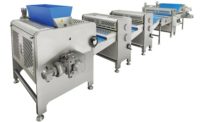Meet John Dough
By Bob Garrison
Stuffed sandwich producer gives convenience store operators quick entrée options.
You might think of him as the “Pied Piper of Hamelin” — but with actual meat pies. And although it’s not actually true, you could say John Bernhardt is the name behind the john dough sandwich. A roofing company owner and entrepreneur, Bernhardt has entranced Wichita, Kan., residents with his homemade bierock, a German sandwich filled with cooked cabbage, ground beef and onion.
By 1998, demand for larger volumes had Bernhardt thinking of how to mass-produce and freeze the popular item. With the help of a cereal chemist, he eventually perfected a high-quality soft bread — straight from the microwave.
Bernhardt then was introduced to agriculture marketing economist Darrell Holaday. Working on behalf of the Kansas Farm Bureau, Holaday helped establish several value-added marketing cooperatives. Once he was introduced to the microwaveable bierock in 2003, Holaday also fell under the product’s spell. And it wasn’t long before he began a business development plan with consumer analysis.
What began as a business study became a full-fledged business in late 2004. That’s when the two men formed Sun Prairie Ventures LLC. Of course, the next step involved finding a contract processor to make such a unique product to Bernhardt’s specifications. Once Holaday connected with Grand Prairie Foods LLC, Sioux Falls, S.D., it was time to get going. Production began in March of 2005.
So where does the john dough brand come from?
“We’re all just ‘John Doe’s’ around this company,” says Holaday, sales manager. “There are no Michael Jordans here, and we don’t have millions [of dollars] to throw at this product.
“One of the marketing slogans — and the one that’s my favorite —is ‘Eat it up. Move it on,’” he adds. “We make this product for John Doe’s of this world, and our theory behind the brand is that john dough is about life. It’s just life. Our product is not a piece of gold —but it is a very convenient sandwich.”
Holaday notes that consumers initially compared the product to the leading national pocket sandwich. “Where our insight came — later — was that people really liked the soft bread,” he notes. “We’re proud of our dough and a product that’s full of filling but not messy when you bite into it.”
Holaday suggests that the items are ideal for the C-store channel, where operators want more meal options with no waste and virtually no labor.
Editor’s Note: Bob Garrison is editor of Refrigerated & Frozen Food (RFF) magazine. This article appeared in its May 2006 issue.



